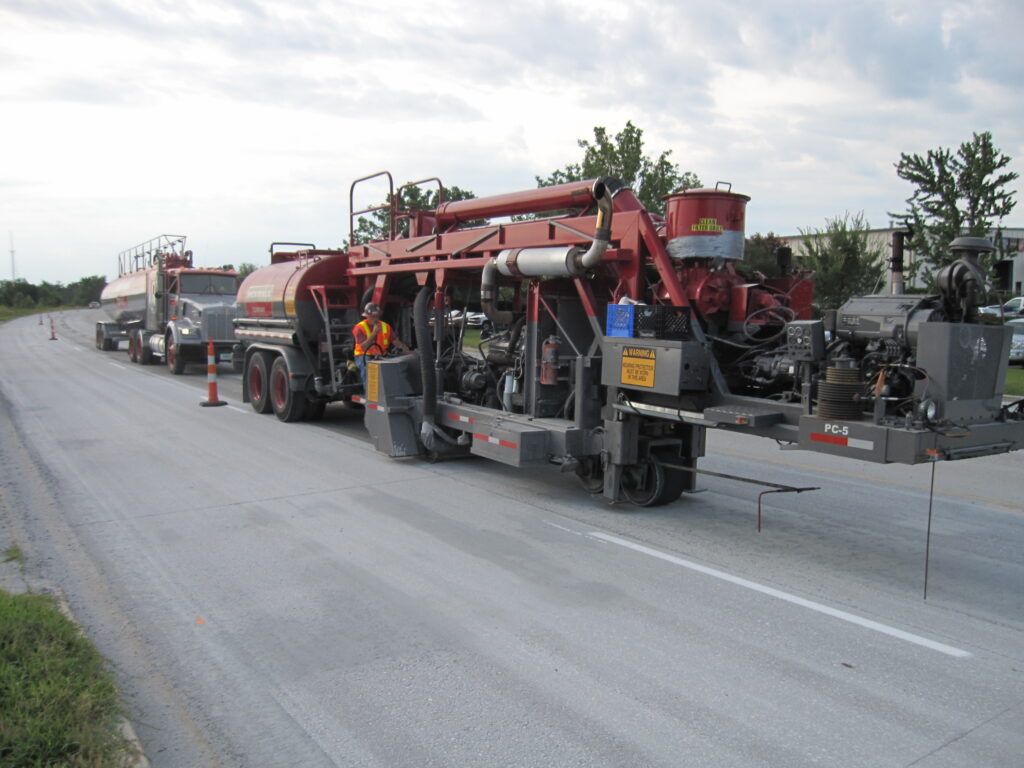 What: Diamond grinding uses closely-spaced diamond saw blades to remove a thin layer at the surface of hardened portland cement Concrete Pavements. The blade assembly is run at a predetermined level (typically 3/16 to 1/4 “) across the pavement surface, producing saw cut grooves. The uncut concrete between each saw cut breaks off, leaving a macroscopically level surface with longitudinal texture. The new riding surface is level, smooth and quieter. The closely spaced grooves give the riding surface excellent texture and frictional properties, reducing the potential for hydroplaning. Diamond grinding is also often done in conjunction with other concrete repair methods to smooth the surface over and around repair sites.
What: Diamond grinding uses closely-spaced diamond saw blades to remove a thin layer at the surface of hardened portland cement Concrete Pavements. The blade assembly is run at a predetermined level (typically 3/16 to 1/4 “) across the pavement surface, producing saw cut grooves. The uncut concrete between each saw cut breaks off, leaving a macroscopically level surface with longitudinal texture. The new riding surface is level, smooth and quieter. The closely spaced grooves give the riding surface excellent texture and frictional properties, reducing the potential for hydroplaning. Diamond grinding is also often done in conjunction with other concrete repair methods to smooth the surface over and around repair sites.
While diamond grinding is sometimes used on asphalt pavements, it should not be confused with milling or scarifying. Milling is an impact process that chips small pieces from the pavement surface. Diamond grinding is an abrasive process.
Where: Diamond grinding is appropriate on pavements with faulting, curling, warping, loss of friction and/or ruts caused by studded tires. It is also used in conjunction with other concrete repair methods.
Why (advantages): Provides a smooth riding surface that is often as good or better than a new pavement, removes faulting at joints and cracks, removes construction curling and moisture-gradient warping of the slabs, and removes other construction or environmental related roughness. Diamond grinding enhances the surface texture and friction, and it reduces road noise and improves safety. The improved macrotexture and the removal of ruts caused by studded tires reduce hydroplaning and accidents in wet weather. Diamond grinding may be done in isolated areas as needed and during off-peak hours. By providing a smooth surface, diamond grinding limits the dynamic loading, therefore extending the useful pavement life. One of the lowest cost and quickest concrete treatments, diamond grinding is a cost-effective pavement preservation treatment.
 Why not (disadvantages): If the load transfer is deficient, faulting of the pavement joints will most likely recur. If load transfer is not restored by other concrete pavement restoration techniques, such as dowel bar (load transfer) retrofit or undersealing, faulting will persist. Diamond grinding does not correct any structural problems such as slab cracking or material problems such as reactive aggregates. While removing more thickness than necessary to address the surface problems is not recommended, studies have shown that diamond grinding does not negatively affect fatigue performance when properly applied. Diamond grinding does not significantly increase material durability.
Why not (disadvantages): If the load transfer is deficient, faulting of the pavement joints will most likely recur. If load transfer is not restored by other concrete pavement restoration techniques, such as dowel bar (load transfer) retrofit or undersealing, faulting will persist. Diamond grinding does not correct any structural problems such as slab cracking or material problems such as reactive aggregates. While removing more thickness than necessary to address the surface problems is not recommended, studies have shown that diamond grinding does not negatively affect fatigue performance when properly applied. Diamond grinding does not significantly increase material durability.
When: Diamond grinding may be done at any time when the distresses occur. The earlier the problems are addressed, the fewer problems will be encountered in the future. Diamond grinding can also be used to correct initial roughness due to construction problems and provide uniform skid resistance and appearance on new pavements.
Estimated life extension: 8-17 years.
For more information, see the Checklist for Diamond Grinding put together by FHWA and FP2 Inc.
